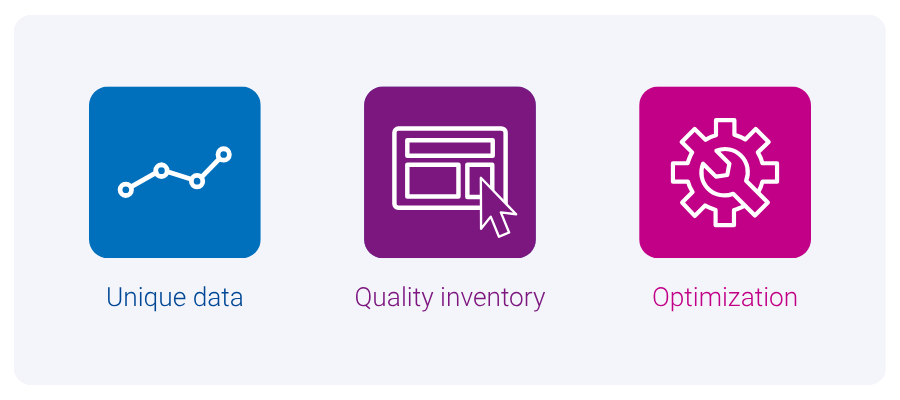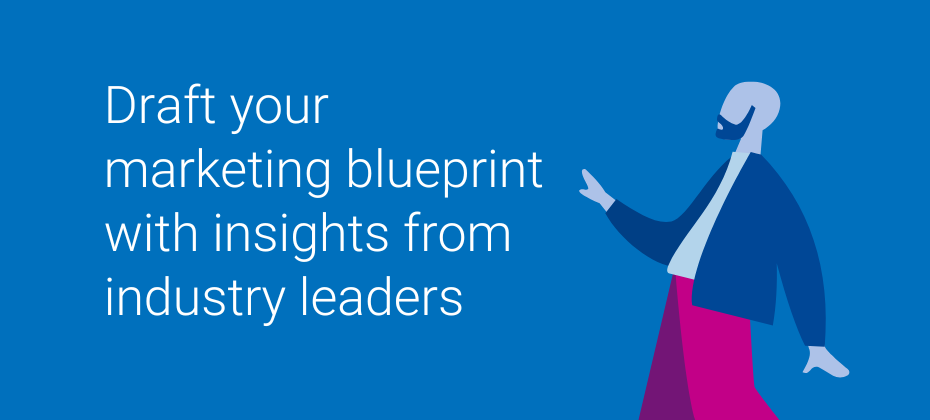At A Glance
Curation is changing how media is bought and sold, moving beyond open auctions and static site lists to more efficient deals. By combining unique data, real-time supply connections, and continuous optimization, curated PMPs reduce waste and improve results. Audigent's, a part of Experian, solutions help marketers achieve measurable outcomes with curated strategies that deliver better targeting, higher engagement, and improved ROI.If you buy media today, you’re already feeling the shift: the best results don’t always come from broad, open auctions or static “safe site” lists; they’re coming from deals that combine the right data with the right inventory and let algorithms optimize in real time. That’s curation. And when it’s done right, it reduces data and media waste for buyers and raises eCPMs (effective cost per thousand impressions) and win rates for publishers.

As part of our Cannes Content Studio series, leaders from Butler/Till, Index Exchange, OpenX, PubMatic, and Yieldmo discuss how curation cuts waste and lifts results.
What is real curation?
Real curation isn’t “packaging inventory.” It’s a strategic framework built on three pillars:
Why it matters: Manual approaches hit a ceiling. They can’t react quickly to shifting content, identity signals, or auction dynamics. That’s where technology partners come in, keeping the optimization loop running continuously.
Intelligence at every touchpoint
Curation isn’t about shifting control between platforms. It’s about better brand decisions, connecting opportunity-rich supply to the brand’s preferred buying platform and enriching each buy with audience data.In practice, supply-side platforms (SSPs) are ingesting richer signals to route inventory more effectively and support frequency caps and deal prioritization, in collaboration with demand-side platforms (DSPs).
“I think we’re seeing a shift toward bringing more DSP capabilities into the SSP, like supply-side targeting and data driven curation. Advancements in areas like CTV are enabling targeting based on content signals, and SSPs are pulling in more data to inform which supply is sent to the DSP, helping with things like frequency caps.”
OpenXMatt Sattel
Why page-level targeting beats static lists
Static domain lists were a useful first step for quality control. The intent was sound, but the approach was too cumbersome for today’s signal-rich buying. Today, AI and contextual engines read the page, not just the site, and adapt in real time.

Page-level logic delivers three key benefits:
- Accuracy by targeting high-intent, page-level content.
- Relevance by matching the creative to both the content and the audience context.
- Speed by enabling campaigns to move away from underperforming pages in real time, without waiting for a manual trafficking change.
“AI-driven contextual engines evaluate the page, not just the domain, to curate inventory in real time. That moves curation from static allowlists to adaptive logic for greater accuracy, relevance, and speed.”
YieldmoSophia Su
Partnerships broaden who influences the buy

Curation works when publishers, agencies, data partners, and platforms share signals and KPIs.
- Horizontal curation (across multiple SSPs) assembles broader, higher-quality reach and resilience, ideal for scale and diversity of supply.
- Vertical curation (an SSP’s in-house product) provides deep controls within a single exchange, useful for specific inventory strategies.
- Creative and data now shape supply and demand: better creative decisioning, tested against richer signals, improves outcomes.
DSPs remain central for activation and pacing. But the sell-side’s growing intelligence means more accurate inventory routing and signal application before a bid ever fires.
“Curation will continue to evolve through deeper data partnerships and expanded use across publishers and agencies, with more sophisticated types of optimization. DSPs will remain critical to activation, even as sell-side decisioning plays a larger role in identifying and shaping the supply to select.”
Index ExchangeMike McNeeley
Curation delivers access and measurable performance

Here’s what curated deals are delivering.
For buyers
| Result | Type of result |
| 36-81% | savings on data segments |
| 10-70% | lower cost per click (CPCs) |
| 1.5-3x | higher click-through rates (CTRs) |
| 10-30% | higher video completion rates |
For publishers
| Result | Type of result |
| 20% | bid density |
| 118% | win rate |
| 10% | revenue on discovered inventory |
| 25% | eCRM on incremental impressions |
Why it works: When data, supply, and optimization are integrated, you reduce waste, surface better impressions, and let algorithms compound your advantage. That’s why curated private marketplaces (PMPs) have grown at ~19% compound annual growth rate (CAGR) since 2019.
“Publishers using supply-side curation see ~15% more diverse buyers and 20–25% better performance than buy-side-only targeting. Smarter packaging and signal application tighten auctions and strengthen outcomes.”
PubmaticHoward Luks
Holistic curation streamlines planning and outcomes

Curation adds the data layer earlier in the buying process, starting at the supply-side. This creates more opportunities to reach the right audience and improves scale and performance. By replacing multiple line items with a single curated deal, campaign setup becomes faster and less error-prone. Curated deals also simplify measurement by including the necessary context for accurate attribution, while dynamic adjustments ensure campaigns remain optimized without requiring manual updates.
“Publishers using supply-side curation see ~15% more diverse buyers and 20–25% better performance than buy-side-only targeting. Smarter packaging and signal application tighten auctions and strengthen outcomes.”
Butler/TillGina Whelehan
It’s much more streamlined, bringing more pieces together so we’re thoughtful and holistic. Adding the audience and data element creates more scale and strategy in how we curate supply and data, and ultimately better results for clients.
The bottom line
Curation has matured from buzzword to performance system. DSPs still anchor activation and pacing, but better sell-side pipes now pre-route inventory and apply signals before any bid starts, making the whole system faster and more accurate. When you combine unique signals, tight supply connections, and always-on optimization, you gain addressability, reduce waste, and achieve better business outcomes for both buyers and sellers.
Curation isn’t just a trend; it’s where programmatic advertising is headed. Start testing curated PMPs today to see the difference for yourself.
Explore curated PMPs with Audigent
Curation FAQs
Curation in performance marketing is the process of combining data, inventory, and optimization to deliver better results. Audigent supports curated strategies through privacy-safe data and advanced integrations.
Curation reduces wasted spend by targeting high-quality impressions and optimizing campaigns in real time. Audigent’s solutions help marketers achieve higher click-through rates, lower costs, and better engagement across channels.
Curated PMPs are deals that use curated data and inventory to deliver measurable results. They help buyers save on data costs, improve ad performance, and achieve better video completion rates, while publishers see higher win rates and revenue.
Audigent provides unique data assets, privacy-safe integrations, and optimization tools that help marketers and publishers create curated deals. Our solutions ensure campaigns are more efficient, targeted, and effective from start to finish.
Horizontal curation combines inventory across multiple platforms for broader reach and diversity, while vertical curation focuses on deep control within a single platform. Both approaches can be tailored to specific campaign goals with Audigent’s expertise.
Latest posts

Healthcare and Life Sciences teams map the patient journey to spot care gaps and guide interventions. However, clinical records cover only what happens inside clinics, not the forces driving patient decisions. Enriching these records with lifestyle, socioeconomic, and consumer-behavior insights reveals the “why” behind health outcomes. That’s where non-clinical insights step in – revealing the real-world forces that shape patient results. To address these blind spots, Experian and Komodo Health have teamed to integrate de-identified insights from millions of patient journeys with Experian’s socioeconomic and lifestyle data. This enriched view lets enterprises see each journey in full, identify care disparities, and craft smarter strategies – while rigorously protecting privacy. Driving tangible outcomes and better patient care This collaboration focuses on turning insights into action. With Experian and Komodo's integrated clinical, socioeconomic, and lifestyle data, Healthcare and Life Sciences teams can move from insight to accuracy, building adherence programs, finding hard-to-reach patients, and demonstrating treatment success. They can: Layer Komodo’s de-identified patient-level medical and pharmacy insights and analytics with Experian lifestyle and socioeconomic attributes Segment patient populations by condition, treatment history, and socioeconomic status Prioritize outreach – reducing waste and focusing resources where care is needed most For instance: Neighborhood-level gaps Identify opportunities to capture untreated patients and improve clinical trial inclusion. Income-related support Flag populations most likely to benefit from cost-saving programs, ensuring communications highlight co-pay assistance or financial relief options. Inside the data stack At the core of Komodo Health's AI-enabled healthcare analytics platform is its Healthcare Map®. This innovative tool integrates de-identified patient-level medical and pharmacy claims data from the patient journeys of over 330 million unique individuals – providing insights on diagnoses, treatments, outcomes, and care patterns across the United States. Experian enhances this data by adding socioeconomic and lifestyle characteristics that influence up to 80% of health outcomes. Together, this combined data effectively addresses essential questions such as: Which neighborhoods face the highest diabetes risk? Where is therapy abandonment spiking? When should co-pay assistance messages drop? How can we accelerate HCP outreach or clinical-trial recruitment? Experian's socioeconomic and lifestyle insights: Fueling data-driven care decisions In this context, Experian provides valuable insights into socioeconomic factors and lifestyle patterns, covering everything from household composition and income ranges to psychographics and other attributes that help build a broader understanding of an individual's circumstances. Where deep patient understanding, health engagement, and real-world evidence converge As healthcare marketing, patient engagement, and real-world data converge, the Experian and Komodo collaboration is empowering Healthcare and Life Sciences teams with fast, actionable insights. Fusing de-identified patient-level clinical data with socioeconomic and lifestyle attributes helps teams engage the right patients, and fuels research from product launches to community programs. It elevates experiences while proving impact with real-world evidence. Ready to utilize these insights? Latest posts

Brand and tech leaders share insights to guide marketers forward Cannes Lions 2025 brought its usual charm, rosé, and lively discussions, but what stood out was a shift in tone: brand and tech leaders aren’t talking in theories anymore – they’re rebuilding how advertising works. From identity to outcomes, the consensus was clear: marketers need bold, structural changes to thrive. At Experian, we spoke with leaders from Ampersand, Butler/Till, Comcast Advertising, Fox, OpenX, Optable, Snowflake, VideoAmp, and Yieldmo. Their message? Foundational change, not incremental tweaks, is the way forward. Here are five moves marketers and CMOs should be making right now. 1. Make identity the foundation, not an add-on Identity must be the core of your marketing strategy, not an afterthought. Building a strong identity framework from the outset ensures that your data and tech stack work seamlessly across channels. This means investing in first-party data assets and identity resolution tools that inform every campaign and tactic. Identity isn’t just a feature; it’s the base layer of everything successful marketers do today. "There’s no AI strategy without a data and identity strategy. Marketers who want to stretch every media dollar and personalize each touchpoint need a unified, deeper view of the consumer – insight they can carry straight into downstream ad platforms.”David Wells, Snowflake Next step: Treat identity resolution as a prerequisite to every campaign, not a task to address later. Align your data management platform (DMP), customer data platform (CDP), and collaboration partners around a unified identity spine (Experian’s or your own) to ensure data flows uninterrupted from planning to reporting. 2. Curate, don't automate. Programmatic is getting personal Programmatic advertising remains relevant, but its purpose is evolving from mere automation to intelligent, data-driven curation. This shift requires moving beyond static site lists to dynamic, page-level contextual engines that determine, in real-time, which impressions to display. Today, it’s about carefully selecting and curating inventory to ensure transparency, quality, and relevance for your audience. Marketers are increasingly turning to private marketplaces (PMPs) that offer curated, brand safe inventory and clear supply paths to deliver meaningful results. Expect continued growth in curated PMPs, AI-assisted forecasting, and supply-side innovations that combine premium connected TV (CTV) inventory with deterministic data. The goal is to reach the right viewer and understand exactly how and why they got there. “What we’re talking about right now is almost like curation 2.0, which is bringing more of the capabilities that historically sat with the demand-side platform (DSP) into the hands of the supply-side platform (SSP) – that is, supply-side targeting, or what we call data-driven curation."Matt Sattel, OpenX Next step: Audit your supply chain. If you can’t clearly explain every step from bid request to delivery, explore curated deals or direct SSP partnerships that align with your quality and transparency standards. 3. Connect teams like you connect data Fragmented results often stem from fragmented teams. Persistent silos (like TV buys on one floor, digital on another, and data science somewhere else) slow down budgets and create inconsistent messaging. Forward thinking organizations are restructuring teams around unified KPIs and shared data. When planners, buyers, and analysts work together (or at least share dashboards), campaigns move faster and creative stays consistent. “We restructured our teams to focus on all forms of video – linear, streaming, and online. This allowed us to embrace partners who cross over these verticals and technical approaches.”Gina Whelehan, Butler/Till Next step: Map your current workflow end-to-end. Where does a brief stall or data stop flowing? Restructure teams or create shared success metrics to eliminate bottlenecks. 4. Turn disconnected data into unified insights Marketers have spent years gathering massive amounts of data, but hoarding data isn’t a winning strategy. The future belongs to those who can collaborate with partners to connect and utilize data effectively, all while respecting privacy and security. Rather than chasing the next data source, leading marketers are finding ways to safely connect data already available in-house or via partners. This might involve data clean rooms, secure data sharing agreements, or joint analytics initiatives – but the common thread is working together on data, not operating in isolation. “We've been encouraging marketers to tie in first-party data and to really utilize that data and to work with trusted sources and deterministic sources in order to overcome a lot of the challenges around signal loss with cookies, in particular. The other way is also clean rooms. Clean rooms really enable the opportunity to collaborate in a private, safe way, and connecting to those more deterministic sources in order to deliver the results that advertisers are looking for.”Carmela Fournier, Comcast Advertising Next step: Identify gaps in your first-party data. Then, collaborate with a provider like Experian to safely match data sets and unlock insights without exposing sensitive info. 5. Focus on outcomes, not clicks Impressions, clicks, and other output metrics have been the currency of marketing for decades. But the consensus at Cannes is that those proxies aren’t enough – business outcomes are what matter now. Marketers must shift their focus to measuring real results, such as sales lift, new customer acquisition, lifetime value, or brand impact, rather than getting bogged down in intermediate metrics. This move to outcome-based measurement changes how campaigns are planned and judged: success is defined by the value created, not just the volume delivered. Unified, identity-based analytics are finally making it possible to see who saw an ad and what they did next, across TV, CTV, and digital. That intel drives smarter budget shifts and tighter creative feedback loops. “Outcome-based measurement is table stakes in today’s media ecosystem, and Ampersand has woven it into almost everything we do. Thanks to Experian’s strength in identity, audience insights, and outcome measurement, we can give advertisers the attribution they need at every stage of the funnel.”Justin Rosen, Ampersand Next step: Identify metrics that matter to your bottom line, then find a partner who can measure them accurately. If measurement stacks don’t talk to each other, they’re holding you back. Preparing for the challenges ahead The common thread across these five moves is connection – connecting data, teams, and outcomes. Marketers who act on these imperatives will be ready for whatever new screen, format, or privacy rule comes next. Experian can help you: Establish an identity spine Enable secure data collaboration in or out of clean room environments Curate premium CTV inventory with deterministic audiences Measure business outcomes across every channel Ready to make your next bold move? Let's start a conversation Latest posts

Marketers are searching for better ways to connect with their audiences across screens and prove results. Optimum Media is at the forefront of this development, helping brands plan, activate, and measure campaigns across linear TV, addressable TV, connected TV (CTV), digital, and social platforms. To support this approach, Optimum Media partners with Experian, combining their subscriber data with Experian’s trusted audience and identity solutions. Together, we help brands not only find the right consumers but also understand their behaviors and measure real outcomes. Here’s how Optimum Media and Experian are working together. Build a complete customer view with rich data from Experian Optimum Media starts with strong first-party data, including viewership and exposure information from millions of households. However, reaching a deeper understanding of these audiences requires more than what subscriber records alone can offer. Through Experian’s Marketing Attributes, Optimum Media gains access to thousands of demographic and behavioral attributes to its data sets. These attributes—such as income ranges, lifestyle interests, and retail purchasing behaviors—help advertisers build a more complete view of the consumer. "We work with trusted partners like Experian to deliver the additional audience insights—like demographics and lifestyle—that are critical for our clients' success."Natalia Irmin, Sr. Director, Strategic Partnerships, Optimum Media Combining Experian’s Marketing Attributes with Optimum Media’s subscriber footprint helps brands segment audiences more precisely, develop refined media plans, and tailor messaging based on the real behaviors and interests of consumers. Move beyond basic targeting with Audience Engine To support more personalized and scalable targeting, Optimum Media uses Audience Engine—Experian’s self-service platform for audience management and activation. Through Audience Engine, Optimum Media can: Access Experian’s syndicated audiences Not just what’s available directly on their platform. Build custom segments Using Experian’s demographic and behavioral insights. Tap into our data marketplace To explore additional segments from Experian and our Partner Audiences through trusted third-party providers. These tools give Optimum Media and its clients the ability to move beyond basic targeting. Whether a brand wants to reach families preparing for back-to-school shopping, in-market car buyers, or upscale consumers planning home renovations, Audience Engine makes it possible to identify and activate those audiences with greater accuracy—based on real data, not guesswork. Extend campaign reach with Experian’s Digital Graph While Optimum Media has a substantial owned footprint, they often work with advertisers who need to extend reach beyond traditional subscriber bases. To support this, they rely on Experian’s Digital Graph. Our Digital Graph connects mobile ad IDs (MAIDs), IP addresses, CTV IDs, and hashed emails into unified household and individual profiles. This enables Optimum Media to identify and reach audiences outside of their network with the same level of accuracy as inside it. For even deeper audience insights, Digital Graph can be bundled with Marketing Attributes. This combination helps advertisers go beyond basic targeting to include real-world behaviors like shopping habits, travel preferences, and lifestyle characteristics. The result: campaigns that do more than deliver impressions—they connect with the right households across any channel. Turn viewership into measurable business outcomes One of the biggest challenges in multiscreen advertising is connecting exposure to real business results. With Experian’s solutions, Optimum Media can: Plan based on audience behaviors across screens, not just age and gender demographics. Activate household-level audiences across linear, CTV, digital, and social. Measure campaign performance using unduplicated reach, frequency, and attribution across devices. By offering advertisers access to a more complete consumer profile and maintaining consistent measurement across channels, Optimum Media and Experian help clients make better decisions about where to spend and how to adjust strategies over time. Why the Optimum Media and Experian partnership delivers Deeper audience understanding: By combining first-party viewership with Experian’s demographic and behavioral data, advertisers gain a fuller picture of who they are reaching. Seamless cross-platform execution: Identity solutions like Digital Graph allow brands to reach audiences across multiple devices and channels without losing precision. "Optimum Media has been instrumental in helping Experian strengthen the precision, quality, and real-world applications of our data. Their ongoing feedback is invaluable in making sure our solutions continue to meet client needs and perform at the highest level."Chris Feo, Chief Business Officer, Experian With a single, trusted partner offering both identity and audience solutions, Optimum Media avoids the complexity many advertisers still face when piecing together different data sets and vendors. “Having Experian’s identity and audience solutions under one roof makes it easier for us to plan, reach, and measure across every channel. It’s a complete solution that simplifies advertising and improves performance.”Natalia Irmin, Sr. Director, Strategic Partnerships, Optimum Media Start building better campaigns with Experian Ready to improve your audience targeting and measurement strategies like Optimum Media? Connect with our team today to learn how Marketing Attributes, Audience Engine, Digital Graph, and our other solutions can help you build stronger, more measurable advertising campaigns. Connect with us About Optimum Media Optimum Media is a multiscreen advertising business that partners with small and medium businesses, as well as national, political, media and entertainment, and agency clients across the United States. They work with advertisers to develop custom multiscreen advertising solutions powered by proprietary technology and a massive aggregated database of audience data points and TV viewership data. Latest posts


